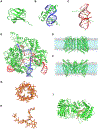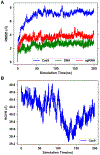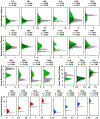CHARMM-GUI Drude prepper for molecular dynamics simulation using the classical Drude polarizable force field
- PMID: 34874077
- PMCID: PMC8741736
- DOI: 10.1002/jcc.26795
CHARMM-GUI Drude prepper for molecular dynamics simulation using the classical Drude polarizable force field
Abstract
Explicit treatment of electronic polarizability in empirical force fields (FFs) represents an extension over a traditional additive or pairwise FF and provides a more realistic model of the variations in electronic structure in condensed phase, macromolecular simulations. To facilitate utilization of the polarizable FF based on the classical Drude oscillator model, Drude Prepper has been developed in CHARMM-GUI. Drude Prepper ingests additive CHARMM protein structures file (PSF) and pre-equilibrated coordinates in CHARMM, PDB, or NAMD format, from which the molecular components of the system are identified. These include all residues and patches connecting those residues along with water, ions, and other solute molecules. This information is then used to construct the Drude FF-based PSF using molecular generation capabilities in CHARMM, followed by minimization and equilibration. In addition, inputs are generated for molecular dynamics (MD) simulations using CHARMM, GROMACS, NAMD, and OpenMM. Validation of the Drude Prepper protocol and inputs is performed through conversion and MD simulations of various heterogeneous systems that include proteins, nucleic acids, lipids, polysaccharides, and atomic ions using the aforementioned simulation packages. Stable simulations are obtained in all studied systems, including 5 μs simulation of ubiquitin, verifying the integrity of the generated Drude PSFs. In addition, the ability of the Drude FF to model variations in electronic structure is shown through dipole moment analysis in selected systems. The capabilities and availability of Drude Prepper in CHARMM-GUI is anticipated to greatly facilitate the application of the Drude FF to a range of condensed phase, macromolecular systems.
Keywords: DNA; RNA; carbohydrate; dipole moment; membrane; protein; protein structure file.
© 2021 Wiley Periodicals LLC.
Conflict of interest statement
Figures













Similar articles
-
Extension of the CHARMM Classical Drude Polarizable Force Field to N- and O-Linked Glycopeptides and Glycoproteins.J Phys Chem B. 2022 Sep 8;126(35):6642-6653. doi: 10.1021/acs.jpcb.2c04245. Epub 2022 Aug 25. J Phys Chem B. 2022. PMID: 36005290 Free PMC article.
-
CHARMM-GUI 10 years for biomolecular modeling and simulation.J Comput Chem. 2017 Jun 5;38(15):1114-1124. doi: 10.1002/jcc.24660. Epub 2016 Nov 14. J Comput Chem. 2017. PMID: 27862047 Free PMC article. Review.
-
Further Optimization and Validation of the Classical Drude Polarizable Protein Force Field.J Chem Theory Comput. 2020 May 12;16(5):3221-3239. doi: 10.1021/acs.jctc.0c00057. Epub 2020 Apr 27. J Chem Theory Comput. 2020. PMID: 32282198 Free PMC article.
-
FFParam: Standalone package for CHARMM additive and Drude polarizable force field parametrization of small molecules.J Comput Chem. 2020 Apr 5;41(9):958-970. doi: 10.1002/jcc.26138. Epub 2019 Dec 30. J Comput Chem. 2020. PMID: 31886576 Free PMC article.
-
CHARMM additive and polarizable force fields for biophysics and computer-aided drug design.Biochim Biophys Acta. 2015 May;1850(5):861-871. doi: 10.1016/j.bbagen.2014.08.004. Epub 2014 Aug 19. Biochim Biophys Acta. 2015. PMID: 25149274 Free PMC article. Review.
Cited by
-
Extension of the CHARMM Classical Drude Polarizable Force Field to N- and O-Linked Glycopeptides and Glycoproteins.J Phys Chem B. 2022 Sep 8;126(35):6642-6653. doi: 10.1021/acs.jpcb.2c04245. Epub 2022 Aug 25. J Phys Chem B. 2022. PMID: 36005290 Free PMC article.
-
Efficient Sampling of Cavity Hydration in Proteins with Nonequilibrium Grand Canonical Monte Carlo and Polarizable Force Fields.J Chem Theory Comput. 2024 Mar 12;20(5):1897-1911. doi: 10.1021/acs.jctc.4c00013. Epub 2024 Feb 28. J Chem Theory Comput. 2024. PMID: 38417108 Free PMC article.
-
Benchmarking the Drude Polarizable Force Field Using the r(GACC) Tetranucleotide.J Chem Inf Model. 2023 Apr 24;63(8):2505-2511. doi: 10.1021/acs.jcim.3c00250. Epub 2023 Mar 30. J Chem Inf Model. 2023. PMID: 36996447 Free PMC article.
-
Relative binding free energy calculations with transformato: A molecular dynamics engine-independent tool.Front Mol Biosci. 2022 Sep 6;9:954638. doi: 10.3389/fmolb.2022.954638. eCollection 2022. Front Mol Biosci. 2022. PMID: 36148009 Free PMC article.
-
Computer-Aided Drug Design: An Update.Methods Mol Biol. 2023;2601:123-152. doi: 10.1007/978-1-0716-2855-3_7. Methods Mol Biol. 2023. PMID: 36445582 Free PMC article.
References
-
- Renaud J-P; Chari A; Ciferri C; Liu W.-t.; Rémigy H-W; Stark H; Wiesmann C, Cryo-EM in drug discovery: achievements, limitations and prospects. Nature Reviews Drug Discovery 2018, 17 (7), 471–492. - PubMed
-
- Penfold J; Wagner NJ, Editorial overview: Recent applications of x-ray and neutron scattering techniques in colloid and interfacial science, characterised by increasing diversity and complexity. Current Opinion in Colloid & Interface Science 2019, 42.
-
- Sotomayor M; Schulten K, Single-molecule experiments in vitro and in silico. Science 2007, 316 (5828), 1144–8. - PubMed
-
- van der Kamp MW; Mulholland AJ, Combined quantum mechanics/molecular mechanics (QM/MM) methods in computational enzymology. Biochemistry 2013, 52 (16), 2708–28. - PubMed
Publication types
MeSH terms
Grants and funding
LinkOut - more resources
Full Text Sources

